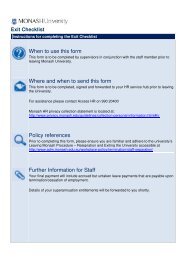Aggregation: Is bigger always better? - Eupian
Aggregation: Is bigger always better? - Eupian
Aggregation: Is bigger always better? - Eupian
You also want an ePaper? Increase the reach of your titles
YUMPU automatically turns print PDFs into web optimized ePapers that Google loves.
<strong>Aggregation</strong><strong>Is</strong> <strong>bigger</strong> <strong>always</strong> <strong>better</strong>?
ContentsPurpose of this guidance 1What is aggregation? 2When should aggregation be considered? 4Why use aggregation? 6Some practical considerations 8Further reading 122
Recent developments in public sector procurement haveraised questions about the extent to which we should poolour requirements and let fewer and larger contracts.The efficiency agenda is driving us towards reducing ourprocurement costs, making use of our combined influenceas buyers and achieving economies of scale. However,there are also increasing concerns about the role of smallfirms in a competitive and healthy market, and the fact thatin some markets a small number of suppliers is able toexert an undue influence on us. As we move towardsadopting a more holistic approach to the markets in whichwe operate, it is becoming increasingly important to assessboth the benefits and potential dangers of aggregation.This guidance is designed to inform decision makingduring the development of organisational procurementstrategies, and during the strategic planning stage prior toa programme or project. It aims to clarify what is meant bythe term ‘aggregation’; identifies the possible advantagesand disadvantages associated with it; and discusses the keyissues that will inform the decision-making process.Purpose ofthis guidanceThe three areas of procurement activity covered by theguidance are:• analysing demand information both within agovernment organisation and across differentorganisations• taking decisions on whether to seek aggregated deals(for example, to engage in collaborative deals betweendepartments)• taking decisions on whether to bundle goods andservices together into a single contract (for example,moving to an outsourced IT service is likely to involvebundling).The target audience is primarily those who take strategicdecisions on procurement, programmes and projects, butalso those who implement such decisions.Key messages• Aggregating, or coordinating, demand information bothwithin and between public sector organisations is animportant step in the journey towards more efficientdealings with markets – and <strong>better</strong> value for money.• Procurement strategy and sourcing decisions on whether toseek aggregated supply should be taken on a case-by-casebasis. The advantages and disadvantages of each optionshould be assessed in the light of the individualrequirement, the capability and capacity of the buyerorganisation(s), the wider government agenda and thefeatures of the commercial marketplace. It may beimportant, for example, to ensure that a competitive supplymarket is safeguarded for the future.It is important to ensure that competitive supply marketsare safeguarded for the future1
What isaggregation?In this guidance paper the term aggregation is used toinclude both aggregation (coordination) of demand andaggregation (consolidation) of supply.<strong>Aggregation</strong> (coordination) of demandAggregating demand means:• analysing historical purchasing data to provide themanagement information necessary to assesspurchasing practices and trends• drawing together information on common or similarcurrent or future requirements – within anorganisation, and with other organisations• assessing the potential for collaborating with otherbusiness units within an organisation, or with otherorganisations, and agreeing to present theserequirements in a coordinated way to the market.When, instead of grouping together information oncommon or similar requirements, we include diverse butrelated requirements (eg IT infrastructure,communications, application development) then we refer tothis as bundling.We would normally, but not <strong>always</strong>, gatherthis information together only within a single organisation.<strong>Aggregation</strong> (consolidation) of supply<strong>Aggregation</strong> of supply means: when the aggregateddemand is presented in a consolidated way to the market, asingle supplier, or fewer suppliers than before, mayrespond and contract with us – leading to a supply base forour new requirement that is rationalised to a greater extentthan previously. Indeed in many cases this is a likely marketresponse to aggregated demand presented in a consolidatedway to the market.<strong>Aggregation</strong> of demand and supply for common goods orservices is illustrated in the diagram (below). At each stagea decision is taken on whether to continue following theaggregation route – for example at stage 3 you could decidenot to present consolidated requirements to the market, orto do so in such a way as to invite the market to bid forsmaller lots.<strong>Aggregation</strong> of demand need not necessarily lead toaggregation of supply, and steps can be taken to specifyrequirements in such a way as to encourage suppliers to bidfor distinct elements of the requirement.Whether or not to dothis would depend on features of your requirement andorganisation, including the costs of letting and managingcontracts, but also on the structure and properties of themarket. For example you may decide, having considered thepotential impact of aggregation on the structure of the market,that it would not be beneficial to longer-term competition toaggregate or bundle all requirements together in a way thatresults in sourcing from a single supplier. Some of the keyissues to be considered are set out in the following sections.An illustration of the aggregation processDemand-side aggregation1. Gathering historical spend data2. Identifying options for rationalisingcurrent/future demand3. Deciding to consolidate requirements topresent them to the market<strong>Aggregation</strong> of supply4. Market provides a response to theaggregated demand2
<strong>Aggregation</strong> of demand does not necessarilylead to aggregation of supply
Whenshould aggregation be considered?During development of an organisation’sprocurement strategyThis guidance is relevant to those developing aprocurement strategy for their organisation. It is designedto help with such decisions as whether to bundle severalrequirements for goods and services together into a singleservice contract (e.g. outsourcing) and decisions aboutwhether to join forces with other organisations to procuregoods or services. It should also be considered whendevising an e-procurement strategy since electronic toolscan make price information more readily available andreduce transaction costs, making aggregation of demandeasier. E-procurement can also expose the potential forreducing transaction costs further by seeking aggregated orbundled supply, but this should be approached withcaution, taking into account the potential impact onmarkets. E-procurement could be used to support a morelimited bundling that maintains competition.Programmes and projectsThe issues outlined in this guidance should be consideredat the earliest opportunity in any programme or project thatwill involve procurement activity, and certainly prior toembarking on the procurement process itself. If a contractis already in place for the requirement, timely considerationshould be given to these issues before the end of thecontract. Using the OGC Gateway stages for reference,this guidance should be considered for StrategicAssessment analysis of programmes at Gate 0, since it mayimpact on the relationship between the various projectswithin a programme. It is also relevant to subsequent stagesof the OGC Gateway process, especially Gate 1 –Business Justification and Gate 2 – Procurement Strategy.These issues should be considered asearly as possible in any project thatinvolves procurement4
Aggregatingrequirements canstrengthendepartments’negotiating positionwith suppliers……but aggregation across government coulddistort markets, by developing a situationwhere too few suppliers are operating……and without people of the right calibre many of thepotential benefits of aggregation can be missed
SomepracticalconsiderationsIn this final section we provide a checklist of questions to be considered in reaching decisions about aggregation.Not every question will apply to each procurement; the aim of the list is to allow you to satisfy yourself that yourprocurement strategy is likely to result in the best possible value for money in the short and longer terms – taking intoaccount the specific features of both your demand and the relevant supply market.DEMAND side issues to considerBaselineSUPPLY side issues to considerWhat has been happening?• What have we been buying? How many and at whatprice? (use industry-standard classifications)• Are there others buying similar things in otherorganisations?• How do the prices we pay compare with others’?• <strong>Is</strong> there ‘silo’ or ‘maverick’ buying within our ownorganisation?• <strong>Is</strong> there room for greater consistency in prices, orgreater standardisation of specifications? Are ourrequirements really that different from those of others?ScopeWhat is my requirement?• Are there several discrete elements to therequirement, for example geographically, or in termsof the overall product or service?• How widely could I draw my net if I wanted to?Do other departments have similar requirements?How similar are they? Overall value for money for all“buying consortium” members must be achieved –taking account of what is essential and what isoptional to each member and also of process costs.This analysis may point to either an aggregated ordisaggregated approach.• Are there other related requirements that could beprocured together (bundled) with this one within myown organisation? Are there elements of the bundledgoods and services that are critical to my business?Should I consider procuring these separately or couldthe necessary controls be put in place through supplychain management? (see OGC’s Contract Innovationguidance for more information).What are the key features of the market and howcompetitive is it?• Are we dealing with a local, regional, national orinternational market? If we were to aggregate ordisaggregate would this change the answer?• If the market is local or regional would there be anybenefits to be obtained from aggregatingrequirements across geographical regions, or wouldsourcing locally be a <strong>better</strong> option?• Are we, collectively, a significant purchaser in themarket? If so, would we achieve greater economies ofscale and/or leverage through presenting aconsolidated requirement to the market?• <strong>Is</strong> this a market where there are significant economiesof scale to be obtained by scaling-up production andlogistics, or would aggregation only deliver reducedtransaction costs?• What are the key factors that influence price in themarket?8
DEMAND side issues to considerSUPPLY side issues to considerScope• What are the business implications of aggregatingrequirements? For example, for a geographicallyspread requirement, how important are responsetimes and service levels? Are there logistical issues toconsider?• What is the degree of competition in the market?1 Are there many players in a strongly competitivemarket? If we aggregate does this change?2 Are we dealing with a monopoly supplier?3 <strong>Is</strong> it a market with a small number of players thatmay be, separately or together, able to exert theirinfluence and exercise market power?• If 1, presenting aggregated demand to the marketmay reduce the benefits of competition, especiallyin markets where a) there are no significant furthereconomies of scale to be achieved and b)procurement and contract management costs willnot be reduced significantly.• If 2 or 3, we may benefit from joining with otherbuyers in order to: a) use our collective buyer powerto put pressure on providers to improve value formoney; or b) take action to create or develop amarket to meet our need.• Does the market tend towards vertical integration, orare the elements of the supply chain provided byseparate companies contracting with one another?(see supply chain section on page 11).• <strong>Is</strong> it possible that aggregated supply could result inincreased risk of distorting the market and ofreducing competition to too few suppliers in thefuture? Would it be <strong>better</strong> not to present consolidatedrequirements to the market, or to do so in such a wayas to invite bidding for smaller lots?• Does the market contain large conglomerate firms orcomplex group structures operating in several discretemarkets? If our aggregation activity increases thecontact between these firms we risk developing anenvironment conducive to collusive behaviour –which reduces the incentives for suppliers to reducecosts and innovate.• Will our activity potentially distort the market byexclusion of a range of suppliers and by raisingbarriers to entry for new suppliers (including SMEs)?How important is this? (for example if we areinterested in innovative solutions – see below).• Will our requirement generate interest amongstpotential suppliers?9
DEMAND side issues to considerDurationSUPPLY side issues to consider• What is the duration of my need? <strong>Is</strong> it possible thatthe requirement may change significantly in the nearfuture? It would be a mistake to aggregate if theduration of need is less than the contract lengthnecessary for the market to secure a return oninvestment.• <strong>Is</strong> there confidence about the long-term goal, stabilityof the organisation and business objectives?• <strong>Is</strong> significant investment required in costly assetsspecific to this requirement? And if so, what is theshelf life of the assets? What contract length wouldallow the supplier to make a reasonable return oninvestment? What size of contract would be neededto generate investment?• <strong>Is</strong> the market rapidly changing, for example throughconsolidation? Could I predict how the market mightlook at the end of a long contract? Would I still begetting value for money at this stage?• Does the market have the capacity for frequentrecompetitions?• Will our requirement generate interest amongstpotential suppliers?Innovation• <strong>Is</strong> this something new and potentially innovative?Will we be doing something that our organisation (orgovernment as a whole) has never done before?• How important are new ideas ?• Has the market carried out this type of work before?If not, is innovation the answer or should we deferthe project until we have undertaken market creationactivity?• <strong>Is</strong> this a high-tech market where there could besignificant changes in a relatively short time? If so,aggregation may make it more difficult toaccommodate innovation or change.• <strong>Is</strong> the innovation in the market taking place in largerfirms (because they have sufficient R&D capacity) orin smaller niche areas amongst smaller companieswith the incentive to innovate?• Do we run the risk of stifling innovation by notcreating a stimulating market environment andengendering competition and/or not being able toexploit the niche market players (eg SMEs)?10
DEMAND side issues to considerManagement and resourcingSUPPLY side issues to consider• What is the capacity and capability of ourprocurement and contract management resources?• What is the current capacity in the market? What elseis going on (both in terms of bidding capacity and ongoingservice capacity)? Are there sufficient playerswith capacity to undertake meaningful competition?• What impact might my current requirement have aspart of the <strong>bigger</strong> impact of public sector demand onthe market? For example, a single organisation’sdemand for a product or service may represent only asmall proportion of total market capacity, but, whenconsidered alongside other organisations’procurement activity, this may represent a risk togovernment through over-dependency, undercapacity,or market distortion.• Are there existing departmental frameworks/call-offcommodity contracts available for some or allelements of the project?Do these contracts meet our needs sufficiently?Would these elements be best procured separately?Bundling – supply chain• Do we have the capacity and capability to deal with alot of smaller contracts and any integration issues?• Do we have the skills and experience to deal with thecomplexity of a large or multi-faceted requirement?For example, do we have the resources available andable to maintain visibility of the supply chainthroughout the contract, if this is needed?• Have the suppliers in the market demonstrated theskills necessary to integrate the different elements inan aggregated or bundled contract?• <strong>Is</strong> one company likely to be best in class in everyelement – or would a combination of firms providebest in class in the totality?• <strong>Is</strong> there strong competition at every level within thesupply chain of my aggregated or bundledrequirement? What impact might reduced competitionat one level have on value for money overall? Can themanagement of the supply chain be left to a primecontractor or should I know who they are proposing orusing as sub-contractors? Are the prime contractors inthis market amenable to encouragement to promoteinnovation through use of SMEs, or in other ways toaccommodate supply chain good practices?• Does industry provide the services/products that Ineed? If there are alternative approaches to sourcingand supply chain, what constitutes acknowledgedbest practice in this market?11
Further informationAbout OGCOGC – the UK Office of Government Commerce – is an officeof Her Majesty’s Treasury.OGC Service DeskOGC customers can contact the central OGC Service Desk aboutall aspects of OGC business. The Service Desk will also channelqueries to the appropriate second-line support. We lookforward to hearing from you.You can contact the Service Desk 8am–6pm Monday–FridayTelephone: 0845 000 4999e-mail: ServiceDesk@ogc.gsi.gov.ukwww.ogc.gov.ukPress enquiriesTelephone: 020 7271 1318Fax: 020 7271 1345e-mail: martin.day@ogc.gsi.gov.ukOffice of Government CommerceTrevelyan House26-30 Great Peter StreetLondon, SW1P 2BYwww.ogc.gov.ukDesigned by Format Design www.format-design.co.uk

















